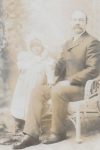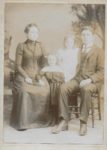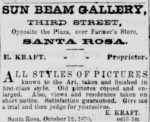Santa Rosa Photographers
Egbert Thomas Briggs (1852-1910)
E. T. Briggs was born in Kentucky and first appears in California in the early 1880s. He arrived in Santa Rosa about 1898 and opened his photography studio on Fourth soon after that. He advertised himself as both a portrait and landscape photographer.
- George Martin Lloyd (circa 1909-1910 ) – portrait by E. J. Briggs. It appears this photo was taken while Mr. Lloyd was visiting family in Sonoma County since records show he resided in Washington state his entire life.
- Unidentified woman – portrait by E. J. Briggs. The high neckline and puffy sleeves were a popular style in the 1890s.
- Unidentified woman – portrait by E. J. Briggs. Diamond-shaped photos were a new style that started to appear near the start of the 20th Century.
- Stamp E.T. Briggs used on the back of his photos.
Norvell Rice Davidson (1838-1921)
Born in Iowa in July 1838, Norvell Davidson traveled with his parents and some of their 13 children across the plains from Jackson County, Missouri to California. The Davidsons settled in Sonoma County in 1852 where Norvell lived with his parents in Santa Rosa. About 1870, he began his career as a traveling photographer. He maintained a studio on Powell Street in Healdsburg, in1874, but in 1876 moved to Ferndale, California. He married Mary Isabelle Mills (1856-1914) in 1879 and settled in Douglas Township, San Joaquin County with their only child Norvella Davidson. Norvell and his family returned to Santa Rosa in 1885 where he established the N. R. Davidson Gallery studio at 219 Fourth Street.
- Sitting for this circa 1900 portrait is the Storey family. Ida, Eunice, Ethelyn, and Albert. Ida Gore was born in Santa Rosa and married Albert in 1893. Albert was a brakeman when they married and later a shoemaker. The family resided at 640 King Street iuntil 1909 when they moved to Alameda County. Ida is buried in the Santa Rosa Rural Cemetery.
- Unidentified man with his beloved dog. His manner of dress including lack of a tie suggests this photo was taken in the 1890s.
- Unidentified Woman _taken in the late 1880s based on hair style and style of puffy sleeves/
- Stamp from back of photos take by Norval Rice Davidson.
Third Street Gallery – Downing, Rea, and Rauscher
Joseph Henry Downing (1840-1914) grew up in New Hampshire before arriving with his parents in Sonoma County at the age of 17. At the age of 28, he travelled back to the east coast to study the art of photography. He returned to Healdsburg and opened a photographic studio on Center Street specialized in portraits. He also travelled the countryside with his wagon load of equipment and his dark room tent. Between 1875 and 1878, Downing was associated with Thomas Rea and Henry Rauscher in theThird Street Gallery in Santa Rosa.
Henry Rauscher (1849-1927) was born in Pennsylvania. He worked as a merchant in Tennessee before he arrived in Sonoma County. From 1875 until 1884 he was partnered with Downing and Rea. He sold out his interest in the gallery to J. K. Piggott and moved to Fresno by 1884 establishing a photographic parlor there. At some point, he gave up photography and worked as a miner and as a proprietor of a cigar store.
Thomas Laughlin Rea (1845-1890) was also born in Pennsylvania. By 1875, Rea was living in Sonoma County and employed as a photographer partnering with Downing and Rauscher in the Third Street Gallery through 1883. In 1884, he opened his own photography studio, called Rea T.L. & Co. which was located on Third Street, south of the Plaza. In 1885, he had partnered with photographer James K. Piggott. By 1886, he had relocated to the town of Liberty in Fresno County where he was a farmer and rancher. When he died, his body was brought by train from Fresno County and buried in the Santa Rosa Rural Cemetery.
- Unidentified woman – circa 1875-1884
- Unidentified woman – circa 1875-1884
- 1875 Third Street Gallery ad.
- Third Street Gallery photographers’ stamp.
Kemp Van Ee, Henry, 1853-1934
A native of New Jersey, Henry KempVan Ee’s parents were born in Holland and arrived in the U.S. in 1845. Eventually, the family travelled west settling in San Francisco. The first reference to Henry’s photographic work is a photograph taken at the “Great Celebrated Centennial Flying Photograph Gallery” in Virginia City, Nevada, in 1875/76. By 1880, Henry was active in Bodie, California and by 1884 he had established a studio in Modesto. In 1886, Henry came to Santa Rosa where his parents had relocated. He opened a studio in the Glenn’s Block at 410 Fourth Street and began advertising in local newspapers, specializing in portraits. He married Nancy Isabelle Culbertson in 1892 and they had three children. The marriage did not end happily. In 1901, Nancy sued for divorce under the charges of desertion and lack of child support. Henry died and was interred at the Stockton Woodland Mausoleum in 1934 while his brother John and his parents are buried at Santa Rosa’s Odd Fellows Cemetery.
Kraft, Phillip Edward (1845-after 1920)
Edward Kraft’s parents were from the Black Forest area of Germany called Wurttemberg and immigrated to the United States in 1839. Edward was born in New York city. both Edward and his brother John are listed as photographers on the 1870 New York census. By October of that year, both had relocated to Santa Rosa and taken over an old photo gallery “over Farmer’s store across from the Plaza”. Edward’s name was always listed as the proprietor and by 1880 John is back in New York. A year earlier in 1879, Edward sold the gallery and the 1880 census has him listed as a Variety Store Keeper living at 166 Second Street.
- Unidentified woman – Carte de Visite by Edward Kraft circa 1870-1879.
- Back of photo taken by Edward Kraft.
- 1870 advertisiement for Edward Kraft’s studio.
Ley, Thomas Allen (1845-1922)
Thomas Allen Ley was born in Van Diemen’s Land – the colonial name of the island of Tasmania used by the British during the European exploration and colonization of Australia in the 19th century. His father was born in England and his mother in Ireland. His brother was also born in Tasmania and his sister in New Zealand. In 1859, naturalization records show the family living in Humboldt County, California. In 1863 at the age of 19 and with the start of the Civil War, Thomas joins the California volunteers in the First Battalion of Mountaineers (Infantry). He musters out in 1865. Two years later he marries Harriet “Hattie” Mulligan previously of Woodland, California who partners with him when he starts his photography business in Calistoga at the age of 35. After Calistoga he opens up a photo gallery in Healdsburg, then Santa Rosa (1893), and then Napa (1894). Eventually, he moves to Los Angeles where he is listed on a 908 voter registration record as a photographer but it is not known if he was still practicing. He dies and is buried in Los Angeles at the age of 76.
McClearie, William, 1878-1969
Joseph William Talbert McClearie was born in Pennsylvania in 1878 and came to California about 1889. By 1892 he had settled in Sonoma County. In 1905, he was living with his father John Patterson McClearie in Santa Rosa. At that time, William worked as a clerk for the grocery firm Cnopius & Company. During his years with the grocery firm, William began the study of photography. In 1911, he was living at 818 Orchard Street and had joined the photographic establishment of Julius F. Scholz located 323 Fifth Street. By 1913 the partnership had ended and William became the proprietor of Elite Studio at 359 Fifth Street, Santa Rosa, where he was known as a leading artist in color photography, which he made a special study. In his gallery he did personal and commercial photography, doing work for the Burbank Press and the Burbank Company. He also partnered with George LaCell to take over 30 images of downtown Santa Rosa after the 1906 earthquake. In 1913, William married Anna C. Cnopius. He and Anna had no children. Anna with her brothers Lewis and John, Jr. were involved as proprietors of Camp Vacation and other Russian River resorts. William continued with his photography studio until about 1918 when he relocated to Camp Vacation and became its manager. He continued in this work until he became the owner of the resort by 1930. He was also a long-time member of the Santa Rosa I.O.O.F. Lodge. William died in 1961. He is buried alongside his wife in the Odd Fellows Cemetery in Santa Rosa.
Piggot, James K., 1857-1941
James Kenneth Piggott is considered one of California’s pioneer photographers and certainly the Santa Rosa photographer with the most business partners and a strong case of wanderlust. Born in 1857, he grew up on Smith Ranch in a town then called Bodega Corners (now Bodega) on the Sonoma County coast. His father, Alexander Kenneth Piggott, was one of the first settlers in the area and the town doctor. In 1885, he married Mary Keenan. They were life-long partners in both marriage and his photography business and had two sons – Harold and Freddie.
After serving three years in the California state militia, James spent time in San Francisco learning the craft of photography. By 1875, at the age of 18 he was employed as a photographer and ten years later in1885, began nearly a decade of partnerships with other photographers in the Third Street Studio in Santa Rosa. During that time, he had four different partners (Rea, Ross, Shaw, and Sheppard). In 1888, James sold his Third Street Studio to Shaw and a year later opened his own studio on the corner of Fourth Street at B Street called The Souvenir Studio. In 1889, he had sold that studio to Mort S. McClaire and relocated to the state of Washington, but returned to Santa Rosa and bought the studio back less than a year later. In 1890, James was partnered with photographer John Ross, but by the end of that year John Ross had left to start his own studio. Two years later, James was running a temporary studio out of a canvas tent in Cloverdale.
Four years later in 1894, James and his wife moved to Quetzaltenango, Guatemala with their two young sons opening a portrait studio and general store. They sold the businesses in 1902 (right after a volcano in that city erupted) and returned to Santa Rosa where four years later, James took photos of the devastation wrought Santa Rosa in the 1906 earthquake. Towards the end of 1906, James and Mary moved to Mexico where James became an authority on western scenery. Mary was his partner in the business helping him by adding oil paint to many of the photos. At some point they returned to California and in 1914, James opened a photography business in San Francisco under the name J.K. Piggott Company. By 1920, his son Harold had joined the business which was now focused on creating photo postcards taking advantage of their current popularity. James never practiced in Sonoma County again, except for a visit in 1925 when he attended a gathering in Bodega to celebrate the placement of historic markers in the area. During the next two decades, James was credited with taking some of the first photos of the Golden Gate and San Francisco-Oakland Bay bridges. He died in San Francisco at the age of 82 in 1941. His son, Harold Boyce Piggott continued running the family business until 1966.
Schramm, Mathieu, 1847-1899
Heinrich Joseph Mathieu Schramm was born in 1847 in Prussia. After immigrating to the US, he traveled to San Francisco where he was naturalized in 1876. In 1877 he became a co-partner at Marden’s National Art Gallery. A year later, he was listed in the Oakland Directory as the proprietor of the Pacific Gallery where he worked as a photographer until 1880 and encouraged patrons to “not risk their lives” by going to San Francisco to have their photo taken. By 1882, he had settled in Santa Rosa where he was the successor to photographers Theodore Miltz and Nicolas Overton – utilizing their former studio at 186 Fourth Street. Besides studio portraits, he offered oil, paint, water color, and India ink art services and received praise for his work along with awards at fairs in St. Louis, San Francisco, Oakland, Petaluma, and Santa Rosa. He also published a German newspaper called the Sonoma County Journal from 1882-1884. After short forays to San Diego and Nevada Counties, he returned to Oakland where he lived until his death from Tuberculosis in 1899 at the age of 52.














